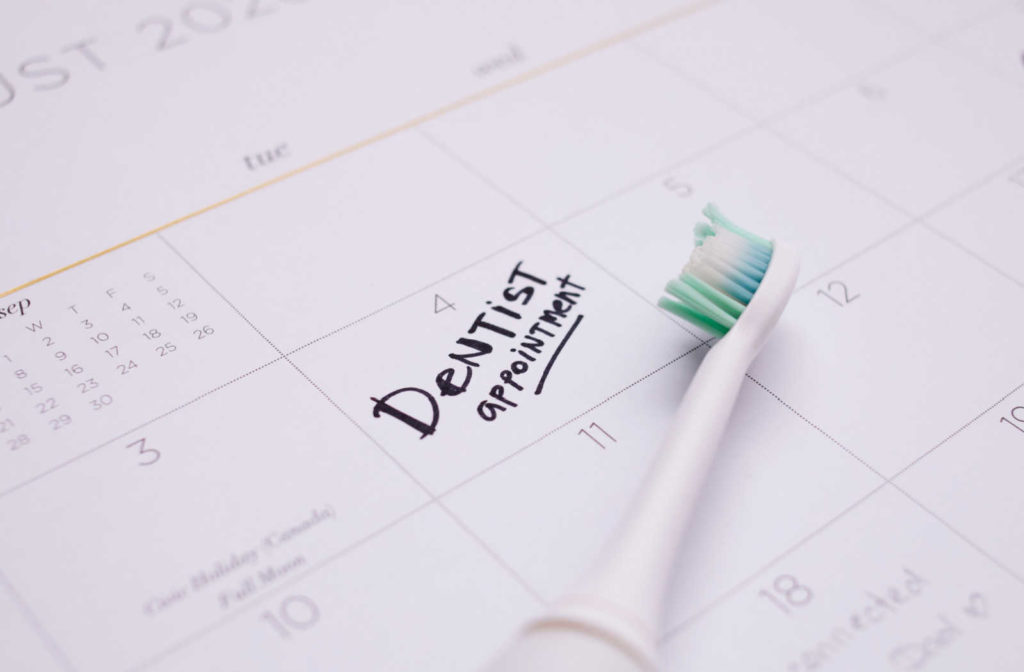Scheduling Appointment Time
What you can expect from your dentist appointment can depend on various factors, from the appointment type to your unique dental health. For example, a routine dental exam will take less time than oral surgery, and a small dental filling will take less time than a larger filling.
Knowing how long an appointment will last can help when arranging rides or scheduling your time. It can also help you prepare for the visit to understand what to expect. So how long can a dental appointment take?
Dental Exam & Cleaning
A routine dental exam and cleanings can take between 2–3 hours. How long your appointment takes depends on the condition of your teeth and any concerns you may wish to discuss.
The appointment includes multiple steps essential for assessing and preserving your oral health. Some standard steps include:
- Physical Exam: generally performed by a dental hygienist; the initial dental exam determines if it’s safe to proceed or if there are any concerns that your dentist should address immediately.
- Removing Plaque & Tartar: a dental hygienist uses a scaler to remove plaque and tartar around the gumline and between teeth. The more buildup you have, the longer this step takes.
- Brushing: a dentist hygienist uses a high-powered electric toothbrush. The gritty toothpaste gently scrubs teeth for a professional clean.
- Flossing: a dentist hygienist flosses thoroughly to remove any remaining buildup or bacteria between your teeth and gum line.
- Fluoride Treatment: fluoride is applied to protect teeth against cavities. A foamy, gel-like fluoride may be applied using a mouthpiece, which requires a minute to sit. Alternatively, a fluoride varnish is painted on teeth individually, which requires no sitting time.
Any additional steps are based on your unique oral health and your dentist’s recommendations. Patients are also likely to receive a second physical examination after the cleaning performed by the dentist.
Dental exams and cleanings are recommended twice yearly, with dental X-rays generally performed once a year. A few x-rays images are captured, with each image taking approximately one minute to process. Typically, the X-rays add a few minutes to your appointment but may take longer if more images are required.

Restorative Dentistry
The purpose of restorative dental care is to repair or replace damaged teeth. Restorative dentistry can save a tooth or provide solutions that look and feel like natural teeth. Some restorative procedures can also improve tooth spacing or correct bite.
Common types of restorative dentistry are:
The duration of your dental appointment will vary depending on the type of treatment. For example, creating a mould for complete dentures will likely take longer than a mould for a single crown.
Appointment length can also increase depending on the filling, implant, or fitting complexity. For example, filling a simple cavity can take 20 minutes, while filling a larger or more complex cavity may take an hour.
The use of anesthetic is another consideration. Many dental procedures use local anesthesia to numb an area temporarily. While most local anesthetics take effect quickly (within 10 minutes), waiting can add extra time to your appointment.
Some minor dental procedures, including fillings, may not require a local anesthetic. When appropriate, skipping the numbing step can reduce your appointment duration.
Oral Surgery
Most oral surgeries are performed by an oral and maxillofacial surgeon—a dental specialty concerned with treating disorders, diseases, injuries and defects. However, there are surgical procedures your dentist may perform, including dental implants, root canals, and tooth extractions.
Dental implants are artificial roots made of titanium metal inserted into the jawbone to replace the natural tooth’s root. A dental implant provides stability so your replacement tooth can feel and look like a natural tooth.
At least 2 visits are required, first to place the implant and second for the crown (visible part of the tooth). Placing the implant can take 60–90 minutes. Recovery can last a few months or up to 6 months.
Then, the custom artificial tooth is placed. How long it takes depends on the type of artificial tooth—such as a crown, bridge, or overdenture—but usually, the appointment takes between 60–90 minutes.
Root Canal Treatment or endodontic therapy is an effective and safe treatment for teeth whose pulp has become inflamed or infected. It can also be required in other situations to help save and restore a tooth.
On average, a root canal treatment can last between 30–90 minutes, depending on the complexity. In some cases, the treatment may require 2 visits; first to thoroughly remove damaged tissue and second to seal the tooth.
Tooth Extraction is the complete removal of a tooth, including the roots in the jawbone. Dental problems and infections caused by tooth decay or advanced gum disease are the most common reason for a tooth’s extraction.
Depending on the complexity, a single tooth extraction can take less than 30 minutes. Removing more than one tooth—such as removing 4 wisdom teeth—can take 1–2 hours. Tooth extractions using sedation dentistry can last slightly longer as time is needed for the sedation and anesthesia to set in.
Book an Appointment
While gettings things done quickly can often seem preferable, your dental appointment should always focus on quality first. Taking the time necessary achieve results is the best way to maintain your teeth and gums effectively.
At Shawnessy Dental, we want to reassure our patients that there’s no rush. Your comfort is our number one priority. When you need a break during your appointment, let us know. You’re also welcome to ask us for an estimate of your appointment time. We’re here to help you plan ahead for your oral health. Contact us today!


